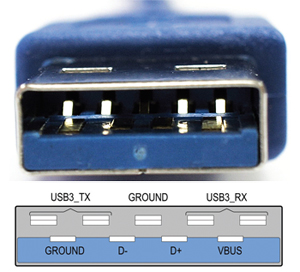The Ubiquitous USB

The Universal Serial Bus, which began development in 1994 and released first in 1996, has evolved to become a major force in the extension of storage and interface communications technologies over its nearly 15-year life span. Originally designed for personal computers by Intel's Ajay Bhatt, the interface is used to connect nearly all forms of human interface devices ranging from personal digital assistants (PDAs), to cameras, smartphones and as power carrying charging interfaces for portable/mobile devices. The USB 1.0 specification, which came out in 1996, had a data transfer rate of 12 Mbps. The first practical version used on any widespread basis was USB 1.1, released in 1998, some four years after the original seven members of Intel, Compaq (HP), Microsoft, DEC, NEC and Nortel had formed the group which developed the now ubiquitous USB.
USB supports simultaneous attachment of multiple devices. USB can identify devices by one of two methods: serial numbers and port addresses. The former is a preferred method because the settings become device specific, with the latter alternative requiring an undisturbed host such that the same address is obtained each time the system boots. In its core spec, the USB Human Interface Device (HID) class is targeted to relatively low speed input devices (e.g., mice, joysticks or keyboards). A wireless specification, called the Wireless Dongle, communicates with up to 15 independent wireless devices connecting to a single USB Host adaptor.
2.0 REVOLUTION
In 2000, USB 2.0 brought about improvements to the more than two billion legacy wired USB connections estimated in use globally as of 2008. In particular, it opened up possibilities for the carriage of video-conferencing cameras, printers, scanners and high density storage devices (e.g., R/W DVD) by increasing bandwidth. USB 2.0 is fully backward compatible with USB 1.1 peripherals.
Wireless USB 1.0 is a 2005 extension that combines both speed and security for the mobilized workforce and social networking lifestyles. Wireless USB supports high-speed communications by utilizing the WiMedia MB-OFDM ultra-wideband (UWB) radio platform from the WiMedia Alliance. The technology is an ISO-published radio standard for high speed, UWB wireless connectivity consisting of a MAC and a MAC-PHY services interface specification. The most recent update (Version 1.5) announced on Jan. 5, 2010, increased the data speed to 1,024 Mbps from the previous 480 Mbps (Version 1.0) at 3 meters. Wireless USB targets streaming video and other applications requiring gigabit-level performance.
HERE COMES SUPERSPEED
The latest version is SuperSpeed USB (SSUSB), also called USB 3.0, released in 2008. This extension brings significant performance enhancements to the USB standard, according to the USB Implementers Forum (USB-IF), the non-profit corporation founded by the organizations that developed the USB specification. In seeking answers to the convergence in media formats and inexpensive storage, increasing the bus bandwidth is essential to returning the quality of experience (QoE) that users have come to expect. SuperSpeed USB has a 5 Gbps signaling rate, offering a tenfold improvement over Hi-Speed USB 2.0.

SuperSpeed USB 3.0 connector configuration with its pair of differential full duplex signal paths. The most obvious change in SSUSB is its additional physical bus which is added in parallel with the existing USB 2.0 bus. Where USB 2.0 utilized four wires consisting of power, ground, and a differential data pair; USB 3.0 adds another two pairs of differential signals (for receive and transmit functions), increasing to eight the number of connections in the cabling. The additional two pairs support the SuperSpeed USB target bandwidth requirements.
In USB 3.0, the signaling method, while still host-directed, is now asynchronous and employs "Sync-N-Go," a technology that minimizes user-wait time. SSUSB eliminates the requirements for continuous device polling through the employment of a bidirectional data interface; as opposed to USB 2.0's which utilizes a half-duplex arrangement permitting data flow in only one direction at a time.
Power efficiency optimization is obtained through lower active and idle power requirements. There is a 50 percent increase in power availability for unconfigured or suspended devices (150 mA up from 100 mA in USB 2.0). For configured devices, 80 percent more power is available (900 mA up from 500 mA in USB 2.0).
A new Powered-B receptacle is defined consisting of two extra contacts, enabling devices to provide up to 1000 mA to another device (such as a Wireless USB adapter). The power receptacle eliminates the need for an external power supply in a wireless adapter, making the new specification an ideal system for a totally wireless link. In a regular wired USB connection to a host or hub, these additional contacts are not used.
USB 3.0 will coexist with USB 2.0; however, USB 3.0 does specify new physical connections and thus new cables are required for the higher speed protocol. The connector remains in its same rectangular shape and contact location as the four USB 2.0 contacts. The new connections carry the duplex receive and transmitted data independently and only come into contact when mated with a proper SSUSB connection.
Look for further developments from the SuperSpeed USB developers conference, to be held in Amsterdam next month.
Karl Paulsen, CPBE, is a SMPTE Fellow, technologist and consultant to the digital media and entertainment industry with Diversified Systems. Contact him at kpaulsen@divsystems.com.
Get the TV Tech Newsletter
The professional video industry's #1 source for news, trends and product and tech information. Sign up below.

Karl Paulsen recently retired as a CTO and has regularly contributed to TV Tech on topics related to media, networking, workflow, cloud and systemization for the media and entertainment industry. He is a SMPTE Fellow with more than 50 years of engineering and managerial experience in commercial TV and radio broadcasting. For over 25 years he has written on featured topics in TV Tech magazine—penning the magazine’s “Storage and Media Technologies” and “Cloudspotter’s Journal” columns.
